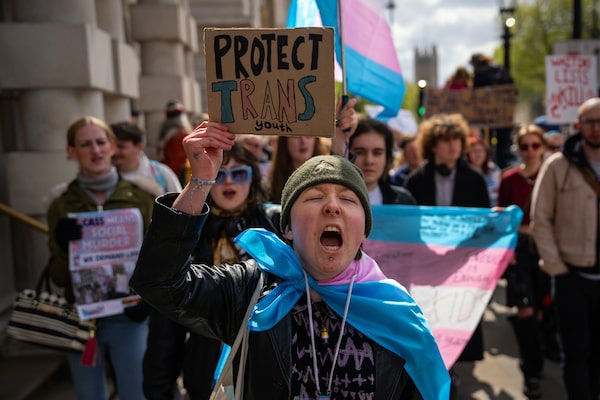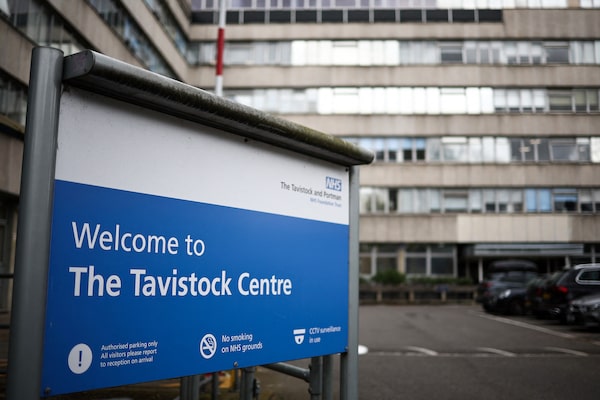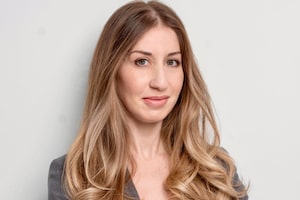
Illustration by Photo illustration by the Globe and Mail
When my daughter was seven months old, I brought her to a drop-in program operated by the province of Ontario. It was my first visit, so I was asked to fill out a form with all the information you’d expect: birthdate, allergies, emergency contact, etc. But then I was asked something I hadn’t yet seen on the dozens of forms I had filled out since she was born: What were her pronouns?
I looked at my daughter, whose level of self-awareness had only recently reached the point of discovering her feet, and figured it was a mistake. Surely, they were asking for my pronouns.
But no, my pronouns were requested elsewhere. This section was specifically for the kids aged 0 to 6 to whom the program was tailored. (Clearly, the question was for kids who could at least speak.) I wiped the spit-up off my daughter’s face and made an executive decision: “she/her.”
As recently as 15 years ago, it would have been unheard of to ask for a child’s – never mind a preschooler’s – preferred pronouns in a casual social setting. But the social climate in Canada started changing in the early 2010s, when school boards across the country began adopting guidelines recommending schools use students’ preferred gender pronouns. The idea was to affirm students’ gender identities without reservation, so that children experiencing dysphoria – that is, an incongruence between their biological sex and gender identities – would feel seen, accepted and welcomed.
Social policies were modelled after the clinical approach to care for trans and gender-diverse youth, which at the time was primarily – and is now effectively exclusively – one of “affirming” care at the major specialty gender clinics across the country. Gender-affirmative care, as defined by the World Health Organization (WHO), means any combination of “social, psychological, behavioural or medical interventions designed to support and affirm an individual’s gender identity.” This “affirmative” approach is the status quo in Canada: in clinics, schools, and yes, even at drop-in centres for preschoolers and babies.
But Canada is increasingly becoming an outlier among its peer nations, many of which have begun to rethink a blanket affirmative approach to care for trans youth. With the exception of the United States, where, like in Canada, most national medical associations still recommend the affirmative approach, countries that once routinely offered medical interventions for children are now placing age-related restrictions on the use of hormones and surgery. Some are even questioning the wisdom of allowing social transitions (the use of preferred names and pronouns) while kids are still navigating adolescence.
The changes happening outside Canada and the U.S. haven’t descended from the bully pulpits of political demagogues, but from a careful review of medical evidence by researchers and clinicians who by-and-large want to do well by children under their care. That’s become near-impossible to do in the U.S., where the issue has morphed into a full-out culture war between Republican lawmakers and trans-rights activists. But the climate in Canada isn’t there … yet.
Over the past six months or so, however, the issue has entered the Canadian political arena, which bodes ill for the prospect of a reasonable national debate. Canadian kids are owed the same careful review of the evidence that medical experts have undertaken elsewhere. But that can only happen if and when the noisiest actors – the political opportunists, the dogmatic activists – get out of the way.
The affirmative approach to care for trans youth is based on a protocol first proposed by Dutch researchers in the 1990s and put into practice after the turn of the millennium. The protocol held that children would be eligible for puberty blockers at 12 if they experienced extreme dysphoria early in life, were properly assessed and diagnosed (which typically took about six months), did not suffer from other mental-health conditions, and lived in supportive environments. Children would be eligible for cross-sex hormones at 16, and surgery at 18.
The researchers observed that starting medical interventions at adolescence would spare kids experiencing extreme dysphoria the psychological trauma that would come with puberty. They also noted that hormone suppression at puberty avoided the need for some future surgeries – a trans man who never developed breasts would not need a mastectomy later, for example – and conferred on parents, children and their health care providers more time to explore their gender identity. It essentially allowed kids to hit the “pause” button to figure out what they wanted. The Dutch protocol was soon adopted around the world.

Trans rights activists take part in a protest against a ban on hormone blockers on April 20, 2024, in London. The ban follows a report by Dr. Hilary Cass on the NHS's gender-identity services for children and young people,Carl Court/Getty Images
Its application has strayed considerably from the guidelines proposed decades ago, however. In Canada, social transitions can happen immediately; the Canadian Paediatric Society recommends physicians “consistently use an adolescent’s preferred name and appropriate pronouns.” Puberty blockers can be prescribed by family physicians prior to children being seen by gender specialists, even though primary care physicians don’t necessarily have comprehensive training in care for kids with gender dysphoria. (This is largely a consequence of long waiting lists for specialty clinics and regional care deserts.)
Many youth who do make it to that first clinic appointment – 62 per cent, according to a study by the research group Trans Youth Can – will receive a prescription for hormone suppression that first day. And though the original Dutch protocol called for holding off on surgery until 18, some younger teens in Canada have nevertheless been undergoing “top” surgeries: According to data compiled by the Canadian Institute for Health Information for the National Post, 303 youth aged 17 and under have had gender-affirming breast reductions or mastectomies since 2018 – a figure that is likely an undercount, since the data exclude surgeries performed in Quebec and at private clinics.
Many countries have also seen a significant increase in the number of youth, and the types of youth, questioning their gender identity. The gender clinic at The Hospital for Sick Children in Toronto, for example, received 100 referrals in 2013, when it first opened; it now says it receives 20 to 30 referrals a month. Census data from 2021 showed that 0.79 per cent of Canadians aged 15 to 24 identified as trans or non-binary, more than the 0.19 per cent who identified as trans or non-binary among those aged 41 to 55.
And then there’s the shift in who is requesting care. Twenty-five years ago, Dutch researchers observed that slightly more children who were born male (who, notably, had experienced dysphoria starting at a young age) were being referred for treatment. Since then, there has been a marked increase in the number of girls – particularly adolescent girls – identifying as trans or non-binary. Indeed, the Trans Youth Can project found that 79 per cent of youth referred for puberty suppression or hormone therapy at 10 clinics across Canada between 2017 and 2019 were born female.

In 2022, the NHS announced that Tavistock, which was then the only dedicated gender identity clinic for children in Britain, would be closed and later replaced with regional care centres.HENRY NICHOLLS/Getty Images
In 2020, the National Health Service (NHS) in Britain commissioned a report by Dr. Hilary Cass to explore the significant increase in referrals for its Gender Identity Development Service at Tavistock (from approximately 50 a year in 2009 to 2,500 in 2019), and what it called a “dramatic change” in referrals from children born male to children born female, many of whom presented with “neurodiversity and other mental health needs.”
In her interim report, Dr. Cass noted that while the Dutch approach called for therapeutic support for kids with neurodiversity or other mental-health needs before, or instead of, hormone treatment, that was not happening at the NHS. Susan Bradley, former chief of psychiatry at The Hospital for Sick Children, raised similar concerns in 2017, when she warned that the rush to “normalize” gender transitions for girls on the autism spectrum was “crossing ethical lines with a particularly vulnerable subset of young people.”
In 2022, the NHS announced that Tavistock, which was then the only dedicated gender identity clinic for children in Britain and the focus of Dr. Cass’s report, would be closed and later replaced with regional care centres. The NHS has since gone even further: In March, it banned the use of puberty blockers for children under 18, concluding after a review that “there is not enough evidence to support the safety or clinical effectiveness of [hormone blockers] to make the treatment routinely available at this time.”
Britain is not alone. In 2020, Finland’s health authority issued new guidelines advocating that psychotherapy, rather than medical interventions, serve as the first line of care for youth questioning their identity. In 2022, Sweden’s National Board of Health and Welfare issued new guidelines recommending against surgical or hormone interventions for youth except for “exceptional cases.” Around the same time, the Académie nationale de médecine in France urged practitioners to employ the “greatest reserve” in prescribing blockers or cross-sex hormones for children. And in March, 2023, the Norwegian Healthcare Investigation Board recommended that hormone and surgical treatment for children be considered “experimental.”
These changes represent a relatively new recognition that steps that were once believed to be totally reversible may not be so reversible after all. Indeed, researchers are now exploring the potential long-term effects of puberty blockers and cross-sex hormones on bone density, fertility, sexual function and cognitive development.
Dr. Lucas Crawford: Regret is a human rite
There are some in the field of gender medicine, such as Dr. Riittakerttu Kaltiala, chief of adolescent psychiatry at Finland’s Tampere University Hospital, who argue that even social transitions can effectively set kids on a path to medical and surgical transition; that using a child’s preferred pronouns without proper assessment and diagnosis could entrench an idea that may, in some cases, be a passing phase. Dr. Cass expressed similar concerns about hormone blockers in her final report for the NHS, published in April: “Given that the vast majority of young people started on puberty blockers proceed from puberty blockers to masculinising/ feminising hormones, there is no evidence that puberty blockers buy time to think, and some concern that they may change the trajectory of psychosexual and gender identity development.”
These questions have raised serious concerns among both parents and medical practitioners considering the stories and statistics of adults who have come to regret their decision to transition as youth. The data are limited, however. Rates of “desistance” or “detransition,” which are themselves considered loaded terms in the trans community, are all over the place.
Experts can’t say why so many more young people are now identifying as trans. Is it greater social acceptance, social contagion or some combination thereof? And though other research in this area remains inconclusive, the uncertainty has clearly been enough to compel some medical bodies to consider whether the harms of an affirmative approach for all youth outweigh the benefits.
Protesters gather at the Alberta Legislature in Edmonton during a rally for trans rights in February. Earlier this year, Alberta Premier Danielle Smith unveiled a host of changes to policies relating to trans people.AMBER BRACKEN/The Canadian Press
Those on the front lines of care for trans youth still face an impossible dilemma: How do they ensure that kids questioning their gender identity feel understood and accepted, without inadvertently setting them on a path they might come to regret? Is it better that some children experiencing extreme gender dysphoria be forced to endure profound trauma in puberty (which will now be the experience of British kids who won’t have access to puberty blockers) if it means that potentially more children won’t undergo transitions they might come to regret? Or is there a way to proceed cautiously, accounting for both?
The irony is that there was a clinic in Canada that employed a more cautious approach. That clinic, the Child Youth and Family Gender Identity Clinic at the Centre for Addiction and Mental Health (CAMH) in Toronto, was run for more than 30 years by Dr. Kenneth Zucker, who recognized that a one-size-fits-all affirmative approach didn’t take into account the unique biology, psychology, family life and social environment of each child referred for care.
When a child was first referred to his clinic, for example, he would often encourage parents to try to help that child become comfortable with his or her own body instead of immediately exploring transition options. In practice, that might have meant slowly removing a boy’s Barbies and replacing them with “gender-neutral” toys such as puzzles, and encouraging that boy to form friendships with other boys. His clinic also prioritized psychological assessment to attempt to understand the root causes of the patient’s dysphoria or other mental-health needs. But that didn’t mean that Dr. Zucker was opposed to social and medical transitions for youth; children that persisted in their dysphoria would be prescribed puberty blockers and guided through further medical transition.
Still, Dr. Zucker’s approach was controversial. Critics argued that the clinic was engaging in “reparative” or “conversion” therapy, which is a harmful practice that attempts to change an individual’s sexual orientation or gender identity. Eventually, CAMH commissioned an external review to assess what was happening at the clinic, and though the authors didn’t come to a conclusion on the conversion therapy question, they did suggest Dr. Zucker was “too conservative” in his approach and “out of step with current clinical and operational practices.” (They also erroneously attributed an encounter where a patient was asked to remove their shirt and called “a hairy little vermin” to Dr. Zucker; this prompted an apology from CAMH.) Dr. Zucker was fired in 2015, and the clinic was subsequently shut down. Dr. Zucker later sued CAMH for defamation and wrongful dismissal, and the case was settled in 2018, when the hospital agreed to pay him more than $500,000.
People protest Alberta Premier Danielle Smith's proposed youth transgender policies outside of an event she is attending in Toronto on Feb. 6, 2024.Arlyn McAdorey/The Canadian Press
The implosion of the CAMH clinic is just one example of the power of a certain type of dogmatic trans activism, which sees any challenge to the affirmative model of care, especially for youth, as threatening, dangerous and even transphobic. In Britain, Dr. Cass observed its effects in her interim report on the Tavistock clinic, where she wrote: “Staff have told us that they feel under pressure to adopt an unquestioning affirmative approach and that this is at odds with the standard process of clinical assessment and diagnosis that they have been trained to undertake in all other clinical encounters.” Those who do challenge the accepted orthodoxy on trans care for youth – like Dr. Zucker in Canada, or Lisa Littman in the U.S., who hypothesized about “rapid-onset gender dysphoria” among youth who come out as trans in adolescence, or Lenny Cornwall in Britain, who called for more debate on best practices for gender care – risk being labelled as regressive, anti-trans and even bigoted.
The passion of the response is, to a certain extent, understandable. Many activists see the path for trans youth as a stark binary, where without affirmative care, kids will descend down a road of self-harm or even suicide. And while it is absolutely true that suicidal ideation is much higher among trans youth compared with the rest of the population, the research is limited as to whether gender-affirming treatment actually reduces suicidality in the long term. The effect of framing the issue in this way, however, is that anyone who questions whether affirmative care is appropriate in all cases can be castigated as not caring about whether trans youth live or die. That makes it incredibly difficult for doctors or researchers to even ask questions about whether certain methods are the right ones, and it creates a void where the primary voices of dissent are those who find opportunity in weaponizing the issue of trans youth care.
American politicians started wielding that weapon in earnest around 2016, when North Carolina governor Pat McCrory signed the state’s “bathroom bill” into law. The bill required people to use the bathroom that corresponded with their biological sex while in government-run buildings (which included schools), and was justifiably seen as a direct attack on the rights of trans people.
Nowadays, it is rare to hear from a Republican candidate vying for any position in government who doesn’t talk about trans issues, especially medical transitions for youth. And while policy changes have been enacted in certain states, they’ve largely been the result of bans by ideologically driven lawmakers – not scrupulous reviews of the evidence by independent medical associations. That renders the issue unavoidably partisan.
It’s a mess that Canada should be wary about emulating.
Last June, the Progressive Conservative government of New Brunswick Premier Blaine Higgs, seen here delivering a speech in January, announced that parental consent would be required if students younger than 16 wanted school staff to call them by their chosen name or pronouns.Stephen MacGillivray/The Canadian Press
Only recently has the notion of rolling back access to affirmative care landed on the lips of Canadian politicians. Back in June, the Progressive Conservative government of New Brunswick Premier Blaine Higgs announced that parental consent would be required if students under 16 wanted school staff to call them by their chosen name or pronouns. Mr. Higgs framed the issue as one of “parental rights,” which long ago became a slogan in U.S. debates about the treatment and care of trans kids. Mr. Higgs used the phrase in a tag line in a fundraising e-mail, and said in the legislature that he thought gender dysphoria was becoming “trendy.” Two of his cabinet ministers quit in protest, though conservative leaders elsewhere weren’t deterred; Saskatchewan Premier Scott Moe announced plans for a similar policy change just a couple of months later.
Alberta Premier Danielle Smith speaks to reporters in Ottawa, on April 12, 2024. Like Mr. Higgs, Ms. Smith said that Alberta schools would soon require parental consent to refer to youth under 16 by their preferred pronouns.Spencer Colby/The Canadian Press
Earlier this year, Alberta Premier Danielle Smith went much further by unveiling a whole host of changes to policies relating to trans people in the province. Like Mr. Higgs, Ms. Smith said that Alberta schools would soon require parental consent to refer to youth under 16 by their preferred pronouns. But she also announced a ban on both top and bottom surgeries for Albertans under 18, and a ban on puberty blockers and cross-sex hormones for those under 16. “Prematurely encouraging or enabling children to alter their very biology or natural growth […] poses a risk to that child’s future that I, as Premier, am not comfortable with permitting in our province,” Ms. Smith said in a video.
The timing of Ms. Smith’s announcement was nakedly political. She will face a leadership review by the United Conservative Party later this year, and it’s clear that her collection of policy changes will be the thank-you basket she brings for the social conservatives who helped her become Premier after a 2022 party leadership race and again through the 2023 provincial election. And strictly as a crass political calculation, it makes sense for Ms. Smith, as well as other conservative politicians in Canada, to pledge to rein in affirmative care: It’s a way for them to throw a bone to their social-conservative bases without alienating the general population in the way that, say, wading in on abortion or gay marriage would. More Canadians will be onside with the proposed changes; an Angus Reid poll from July showed that 78 per cent of Canadians believe parents should be informed if their kids want to change their pronouns, while a Leger poll from February showed that 42 per cent of Canadians oppose puberty blockers and hormones for children under 18. This is, thus, a relatively “safe” issue for conservative politicians to campaign on.
That, of course, does not make doing so ethical, compassionate or even smart, if their goal is actually to enact legislation that lasts. Trans kids already face enormous social, physical and psychological challenges, and turning their plight into a political football will absolutely exacerbate the ostracism they already face. In order to meaningfully reform the perceived excesses of affirmative care, the direction has to come from the experts – the front-line doctors, the researchers, the national and regional medical associations – and not from political leaders, whose legislation can simply be undone by future governments driven by different ideologies. And yet by turning this into a partisan political issue, leaders make it harder for non-partisan experts to weigh in without being seen as carrying water for the party in government.
Canada is at an inflection point. Our universal approach to affirmative care is falling out of favour among our peer nations, which have taken note of major shifts in the numbers and types of trans kids today and have become wary of setting some on an irreversible path. There’s still so much we don’t understand about the effects of both social and medical transitions, as well as about the risks of asking dysphoric youths to languish in a body they perceive not to be their own for a little bit longer.
But what’s clear is that those uncertainties must be explored for the sake of Canadian youth. Yes, explored – not exploited or shouted down. We can either take up that challenge, or let the loudest voices fight amongst themselves, leaving Canadian kids to suffer the impacts.
 Robyn Urback
Robyn Urback